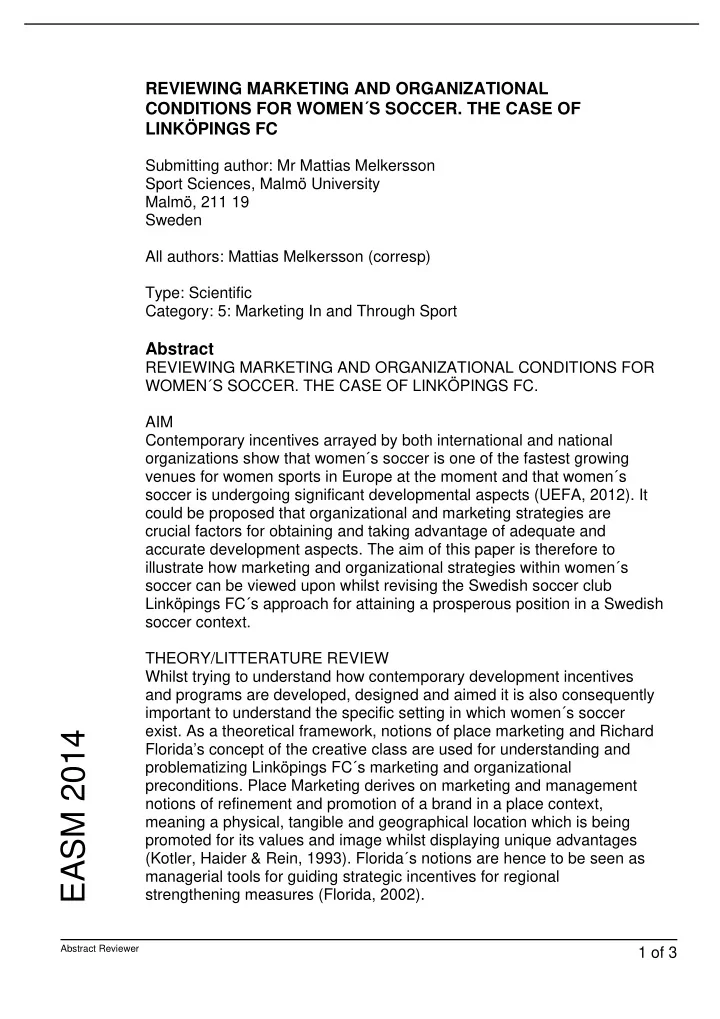

REVIEWING MARKETING AND ORGANIZATIONAL CONDITIONS FOR WOMEN´S SOCCER. THE CASE OF LINKÖPINGS FC Submitting author: Mr Mattias Melkersson Sport Sciences, Malmö University Malmö, 211 19 Sweden All authors: Mattias Melkersson (corresp) Type: Scientific Category: 5: Marketing In and Through Sport Abstract REVIEWING MARKETING AND ORGANIZATIONAL CONDITIONS FOR WOMEN´S SOCCER. THE CASE OF LINKÖPINGS FC. � � AIM� Contemporary incentives arrayed by both international and national organizations show that women´s soccer is one of the fastest growing venues for women sports in Europe at the moment and that women´s soccer is undergoing significant developmental aspects (UEFA, 2012). It could be proposed that organizational and marketing strategies are crucial factors for obtaining and taking advantage of adequate and accurate development aspects. The aim of this paper is therefore to illustrate how marketing and organizational strategies within women´s soccer can be viewed upon whilst revising the Swedish soccer club Linköpings FC´s approach for attaining a prosperous position in a Swedish soccer context.� � THEORY/LITTERATURE REVIEW� Whilst trying to understand how contemporary development incentives and programs are developed, designed and aimed it is also consequently important to understand the specific setting in which women´s soccer exist. As a theoretical framework, notions of place marketing and Richard EASM 2014 Florida’s concept of the creative class are used for understanding and problematizing Linköpings FC´s marketing and organizational preconditions. Place Marketing derives on marketing and management notions of refinement and promotion of a brand in a place context, meaning a physical, tangible and geographical location which is being promoted for its values and image whilst displaying unique advantages (Kotler, Haider & Rein, 1993). Florida´s notions are hence to be seen as managerial tools for guiding strategic incentives for regional strengthening measures (Florida, 2002). � Abstract Reviewer 1 of 3
� METHODOLOGHY/RESEARCH DESIGN� As an overall research design, this paper focuses its agenda on depicting the club of Linköpings FC from a case study methodology. When using case study as a methodological viewpoint, one important factor is to depict a sufficient and comprehensive presentation of the case for understanding case specific contextual opportunities and limitations (Yin, 2014). For depicting a sufficient case, interviews with club specific officials, Club Director and Marketing Manager, an audience questionnaire at a home game, together with document analysis consisting of scrutinizing city and club official documents, marketing material, websites, and newspaper articles have been carried out. Using a mixed method approach for attaining empirical data is important for observing a presented club identity in correlation to a perceived image of the club. � � RESULTS/DISCUSSION� The empirical data shows that the city of Linköping has an open agenda on promoting the city as a sports city. The incentive for promoting Linköping as a sports city seems to come from a perception of sports as a good catalyst for a prosperous marketing of a city. This has partially resulted in the building of several new venues for local sports and for Linköpings FC in specific it has resulted in the building of a new arena which solely accommodates soccer. However, the new arena was built in conjunction to the city´s acquisition of becoming a host city of the UEFA Women´s Euro 2013. This raises questions whether the club Linköpings FC could have been able to strive for a prosperous agenda without the strong local sporting incentive. Linköpings FC is also part of a somewhat unique collaboration with a local ice hockey club named LHC which is a recurring top performing club in the Swedish professional hockey league SHL. The collaboration consists of shared spatial settings and facilities but also a shared managerial and organizational structure, however with separate fiscal operations (Linköpings FC, 2014).� � CONCLUSION� The case of Linköpings FC shows that local connectedness is very important for both Linköpings FC´s and the city of Linköping´s strategic approach for gaining recognition and attention. It is however also EASM 2014 interesting to see how a city, which could be classified as having a large concentration of the creative class according to Florida, also focuses its agenda on sport for financial growth. This considered whilst there is little evidence which supports notions of sports as attaining fiscal success for cities. The collaboration between Linköpings FC and the ice hockey club LHC has not only assisted Linköpings FC in marketing and organizational strengthening aspects, it has also strengthened the club moving towards an increased professionalization. The collaboration also illuminates an importance of considering alternative constellations for finding prosperous strategies for a thriving development, putting traditional Abstract Reviewer 2 of 3
notions aside for alternative and innovative ideas. References Florida, R. (2002) The rise of the creative class: and how it´s transforming work, leisure, community and everyday life. New York: Basic Books. � � Kotler, P., Haider, H.H & Rein, I. (1993) Marketing Places. Attracting Investment, Industry, and Tourism to cities, States, and Nations. New York: The Free Press. � � Linköpings FC (2014) Interviews with the Club Director and the Marketing Manager. (2014-03-24). � � Union of European Football Associations (UEFA). (2012) UEFA’s Women’s Football Development Programme.� http://www.uefa.com/MultimediaFiles/Download/EuroExperience/ Women/ WFDP/ � 01/72/39/37/1723937_DOWNLOAD.pdf (accessed 2012-03-31).� � Yin, R. K. (2014) Case Study Research. Design and Methods. London: Sage Publications. EASM 2014 Abstract Reviewer 3 of 3
Recommend
More recommend